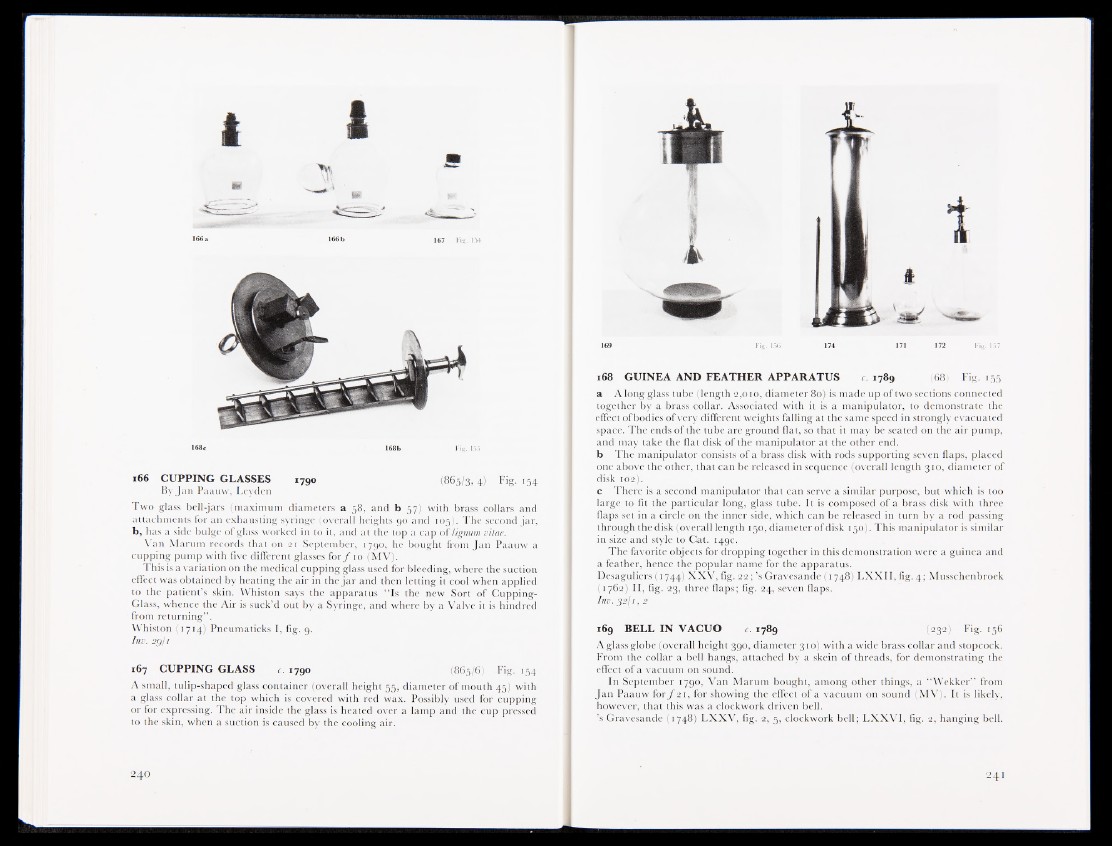
168c 168b Tig. 155
166 CUPPING GLASSES 1790 (865/3, 4) Fig. *54
By Jan Paauw, Leyden
Two glass bell-jars (maximum diameters a 58, and b 57) with brass collars and
attachments for an exhausting syringe (overall heights 90 and 105). The second jar,
b, has a side bulge of glass worked in to it, and at the top a cap of lignum vitae.
Van Marum records that on 21 September, 1790, he bought from Jan Paauw a
cupping pump with five different glasses for ƒ 10 (MV).
This is a variation on the medical cupping glass used for bleeding, where the suction
effect was obtained by heating the air in the jar and then letting it cool when applied
to the patient’s skin. Whiston says the apparatus “ Is the new Sort of Cupping-
Glass, whence the Air is suck’d out by a Syringe, and where by a Valve it is hindred
from returning” .
Whiston (1714) Pneumaticks I, fig. 9.
Inv. 2g/j
167 CUPPING GLASS c. 1790 (865/6) Fig. 154
A small, tulip-shaped glass container (overall height 55, diameter of mouth 45) with
a glass collar at the top which is covered with red wax. Possibly used for cupping
or for expressing. The air inside the glass is heated over a lamp and the cup pressed
to the skin, when a suction is caused by the cooling air.
168 GUINEA AND FEATHER APPARATUS c. 1789 (68) l ig. 155
a A long glass tube (length 2,010, diameter 80) is made up of two sections connected
together by a brass collar. Associated with it is a manipulator, to demonstrate the
effect of bodies of very different weights falling at the same speed in strongly evacuated
space. The ends of the tube are ground flat, so that it may be seated on the air pump,
and may take the flat disk of the manipulator at the other end.
b The manipulator consists of a brass disk with rods supporting seven flaps, placed
one above the other, that can be released in sequence (overall length 310, diameter of
disk ioflsjfl
c There is a second manipulator that can serve a similar purpose, but which is too
large to fit the particular long, glass tube. It is composed of a brass disk with three
flaps set in a circle on the inner side, which can be released in turn by a rod passing
through the disk (overall length 150, diameter of disk 150). This manipulator is similar
in size and style to Cat. 149c.
The favorite objects for dropping together in this demonstration were a guinea and
a feather, hence the popular name for the apparatus.
Desaguliers (1744) XXV, fig. 22;’s Gravesande (1748) LXXII, fig. 4; Musschenbroek
111762) II, fig. 23, three flaps; fig. 24, seven flaps.
Im -32; 1, 2
169 BELL IN VACUO c. 1789 (232) Fig. 156
A glass globe {overall height 390, diameter 310) with a wide brass collar and stopcock.
From the collar a bell hangs, attached by a skein of threads, for demonstrating the
effect of a vacuum on sound.
In September 1790, Van Marum bought, among other things, a “Wekker” from
Jan Paauw for ƒ 21, for showing the effect of a vacuum on sound (MV). It is likely,
however, that this was a clockwork driven bell.
’s Gravesande (1748) LXXV, fig. 2, 5, clockwork bell; LXXVI, fig. 2, hanging bell.